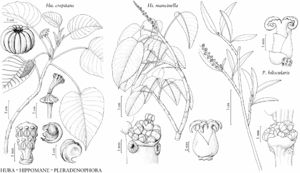Hura crepitans
Sp. Pl. 2: 1008. 1753.
Trees, to 30 m; latex copious, caustic. Leaves: stipules leaving scar around stem, 6–10 × 2–4 mm; petiole 10–20 cm, glands 2 adaxially at apex; blade broadly ovate to orbiculate, 10–25 × 8–15 cm, base cordate, margins crenate-serrulate with 10–20 teeth on each side, apex acuminate; midvein and secondary veins prominent. Staminate inflorescences: peduncle (2–)5–10(–15) cm, fertile portion 2–5 cm, 60–80-flowered; staminate bracts membranaceous, enclosing flowers prior to anthesis. Pedicels: pistillate 1–5 cm. Staminate flowers: calyx cup-shaped, 1 mm, 3–5-lobed; staminal column to 2.5 mm, anthers usually in 2, rarely in 3, whorls. Pistillate flowers red; calyx cup-shaped, 3–5(–8) mm, 5-lobed; style 30–50 mm, terminating in thick apical disc 1 cm diam. with 5–20 radiating lobes 5–10 mm. Capsules depressed-globose, 3–5 × 6–10 cm. Seeds brownish, 15–20 mm diam., 5–8 mm thick, smooth.
Phenology: Flowering Jan–May; fruiting (Mar–)May–Sep.
Habitat: Hammocks and disturbed ground.
Elevation: 0–10 m.
Distribution
Introduced; Fla., West Indies, Central America, South America, widely cultivated and often escaped throughout tropical regions of the world.
Discussion
In the flora area, Hura crepitans is found only in Miami-Dade and Monroe (Keys only) counties. The capsules dehisce explosively, producing a loud sound and throwing the seeds up to 45 m (M. D. Swain and T. Beer 1977).
Selected References
None.
